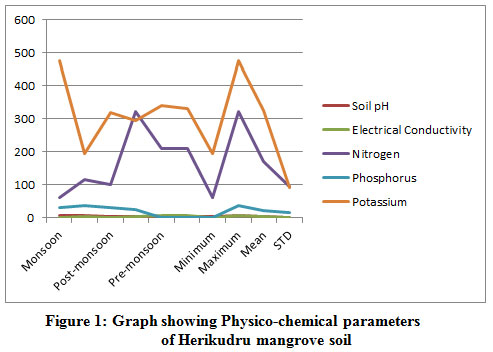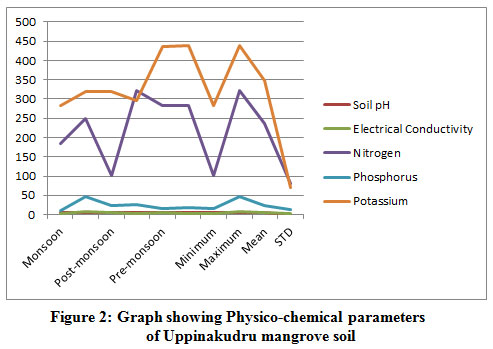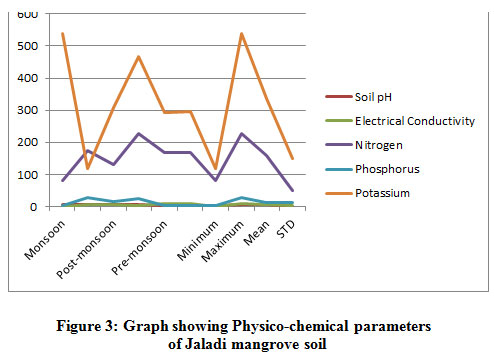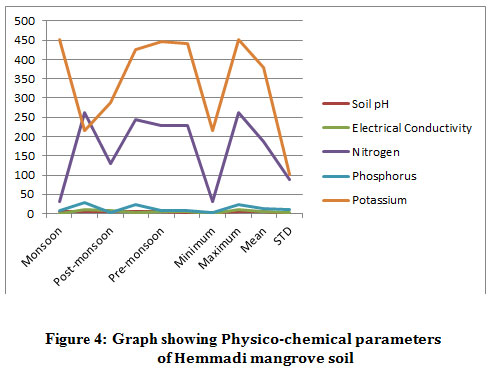Physico-Chemical Analysis of Mangrove Soil, Kundapura, Karnataka, India
Corresponding author Email: vijay.kshalli@gmail.com
DOI: http://dx.doi.org/10.12944/CWE.15.3.27
Copy the following to cite this article:
Kumar K. M. V, Kumara V. Physico-Chemical Analysis of Mangrove Soil, Kundapura, Karnataka, India. Curr World Environ 2020;15(3).
DOI:http://dx.doi.org/10.12944/CWE.15.3.27Copy the following to cite this URL:
Kumar K. M. V, Kumara V. Physico-Chemical Analysis of Mangrove Soil, Kundapura, Karnataka, India. Curr World Environ 2020;15(3). Available from: https://bit.ly/35Hf7rq
Download article (pdf) Citation Manager Publish History
Select type of program for download
| Endnote EndNote format (Mac & Win) | |
| Reference Manager Ris format (Win only) | |
| Procite Ris format (Win only) | |
| Medlars Format | |
| RefWorks Format RefWorks format (Mac & Win) | |
| BibTex Format BibTex format (Mac & Win) |
Article Publishing History
| Received: | 14-04-2020 |
|---|---|
| Accepted: | 06-11-2020 |
| Reviewed by: | 
 Hiteshi Tandon
Hiteshi Tandon
|
| Second Review by: |

 Deep Chakraborty
Deep Chakraborty
|
| Final Approval by: | Dr Hiren B Soni |
Introduction
Mangroves are tropical plants which grow along the tropical coastlines of the world. They are found growing along shallow sheltered coasts. Mangroves are responsible for several economic as well as ecological services1.
Mangroves are the most productive and biologically important ecosystems of the world, as they offer ecological balance, goods and offerings to humans; performs an essential position in nature with the aid of using nurturing ecological, safety and social services2. Like any other ecosystem mangrove ecosystem is likewise a cradle and predominant Bioresource for plenty beneficial bioingredients together with many different species which are directly or indirectly depending on the sustenance of mangrove ecosystem3. Marine ecosystems are numerous habitats, endowed with physical, chemical, and geographical versions in the ecosystems, wherein the gradation from relatively productive organisms to especially specialised organisms exists4. Mangrove wetlands are one of the world’s most threatened ecosystems and are vital wetlands alongside tropical and subtropical coasts, mainly along deltas and bays in which rivers discharge freshwater and sediment to the sea that offer ecological security, environmental sustainability and economic prosperity5.
Mangroves are salt lenient forest ecosystems of tropical as well as subtropical intertidal areas of the arena. There may be no additional group of plants with such relatively advanced morphological as well as physiological adaptations to severe situations6. Mangrove soils arise in coastal environments of tropical and subtropical regions and they will be originated from sedimentary material deposited via river as well as marine actions or from the amendment of the sedimentary substrate. The sediments are similarly reformed by means of organisms amended to flood, anaerobic as well as salt conditions. Soils of mangrove ecosystems are the end result of complicated interactions amongst abiotic elements, along with tidal oscillations and biotic factors. Soils offer vital nutrients for mangrove species growth and bodily structure for plant anchorage and balance7.
Mangrove habitat is the breeding floor to fishes, crabs, shrimp species and mollusks. The trees are home to an array of nesting, breeding as well as migratory birds. When mangrove forests are vacant precious habitat is gone astray, intimidating the survival of myriad species. Hence there is a requirement of studying mangrove soil which supports the vegetation.
Materials and Methods
The domain of study is located at Kundapura, 440 km from Bangalore and 37 km from Udupi, at 13°37'24" N latitude and 74°41'30" E longitude and maximum elevation of 18 meters above sea level. Four study sites (Table:1) have been selected beside the backwaters of the Haladi River.
Table 1: Study Sites
|
Study sites |
Latitude |
Longitude |
Elevation (Feet) |
|
Herikudru |
13°38'28"N |
74°42'01"E |
28' |
|
Uppinakudru |
13°39'21"N |
74°41'59"E |
25' |
|
Jaladi |
13°39'41"N |
74°42'16"E |
16' |
|
Hemmadi |
13°40'46"N |
74°41'20"E |
32' |
Notes: Monsoon (June to September); post-monsoon (October to January); pre-monsoon (February to May); Kg/ha: Kilogram per hectare; dS m-1: deciSiemens per meter, Min: Minimum; Max: Maximum, STD: Standard Deviation.
Herikudru
This region is a small island wherein the trees are planted through the local people to protect their agricultural fields from erosion.
Table 2: Physico-chemical parameters of Herikudru mangrove soil
|
Soil parameters |
Monsoon |
Post-monsoon |
Pre-monsoon |
Min |
Max |
Mean |
STD |
|||
|
2010 |
2011 |
2010 |
2011 |
2011 |
2012 |
|||||
|
Soil pH |
6.51 |
6.66 |
5.93 |
4.76 |
5. 91 |
5.68 |
4.76 |
6.66 |
5.9 |
0.75 |
|
Electrical Conductivity |
1.85 |
4.83 |
2.51 |
4.02 |
8.08 |
8.08 |
1.85 |
8.08 |
4.89 |
2.68 |
|
Nitrogen |
61.2 |
116 |
102 |
323 |
210 |
210 |
61.2 |
323 |
170.36 |
95.90 |
|
Phosphorus |
32.30 |
36.41 |
30.29 |
25.27 |
2.37 |
1.37 |
1.37 |
36.41 |
21.33 |
15.50 |
|
Potassium |
476.69 |
194.25 |
318.55 |
294.68 |
341.36 |
331.36 |
194.25 |
476.69 |
326.14 |
90.95 |
 |
Figure 1: Graph showing Physico-chemical parameters of Herikudru mangrove soil Click here to view figure |
Uppinakudru
This location is completely under the tidal influx with numerous mangrove patches
Jalady
This area is absolutely under tidal influence with dense growth of mangroves.
Table 3: Physico-chemical parameters of Uppinakudru mangrove soil
|
Soil parameters |
Monsoon |
Post-monsoon |
Pre-monsoon |
Min |
Max |
Mean |
STD |
|||
|
2010 |
2011 |
2010 |
2011 |
2011 |
2012 |
|||||
|
Soil pH |
5.30 |
6.34 |
5.91 |
4.76 |
6.43 |
6.43 |
5.30 |
6.43 |
5.86 |
0.69 |
|
Electrical Conductivity |
1.92 |
7.49 |
5.40 |
4.02 |
4.25 |
3.25 |
1.92 |
7.49 |
4.38 |
1.90 |
|
Nitrogen |
185.5 |
250 |
101 |
323 |
282 |
282 |
101 |
323 |
237.25 |
80.94 |
|
Phosphorus |
9.48 |
47.27 |
22.82 |
25.27 |
15.46 |
17.46 |
15.46 |
47.27 |
22.96 |
13.14 |
|
Potassium |
284.12 |
318.55 |
320 |
294.68 |
435.59 |
439.59 |
284.12 |
439.59 |
348.75 |
70.18 |
 |
Figure 2: Graph showing Physico-chemical parameters of Uppinakudru mangrove soil Click here to view figure |
Hemmady
This region lies along the back waters of the river Haladi and the vicinity is absolutely under the tidal influence with good formations of mangroves.
Table 4: Physico-chemical parameters of Jaladi mangrove soil
|
Soil parameters |
Monsoon |
Post-monsoon |
Pre-monsoon |
Min |
Max |
Mean |
STD |
|||
|
2010 |
2011 |
2010 |
2011 |
2011 |
2012 |
|||||
|
Soil pH |
6.10 |
6.36 |
6.23 |
5.45 |
4.83 |
4.83 |
4.83 |
6.36 |
5.63 |
0.69 |
|
Electrical Conductivity |
0.02 |
5.54 |
7.92 |
4.89 |
9.60 |
9.60 |
0.02 |
9.60 |
6.26 |
3.64 |
|
Nitrogen |
80.0 |
173 |
130 |
229 |
168 |
168 |
80.0 |
229 |
158 |
49.66 |
|
Phosphorus |
2.03 |
28.62 |
14.83 |
24.00 |
3.48 |
3.48 |
2.03 |
28.62 |
12.74 |
11.57 |
|
Potassium |
537.63 |
117.43 |
307.41 |
468.33 |
292.79 |
294.79 |
117.43 |
537.63 |
336.39 |
148.53 |
 |
Figure 3: Graph showing Physico-chemical parameters of Jaladi mangrove soil Click here to view figure |
Table 5: Physico-chemical parameters of Hemmadi mangrove soil
|
Soil parameters |
Monsoon |
Post-monsoon |
Pre-monsoon |
Min |
Max |
Mean |
STD |
|||
|
2010 |
2011 |
2010 |
2011 |
2011 |
2012 |
|||||
|
Soil pH |
6.12 |
6.07 |
6.03 |
5.72 |
4.84 |
3.84 |
3.84 |
6.12 |
5.43 |
0.91 |
|
Electrical Conductivity |
0.30 |
9.35 |
8.44 |
3.58 |
6.63 |
6.63 |
0.30 |
9.35 |
5.82 |
3.35 |
|
Nitrogen |
30.7 |
261 |
130 |
243 |
229 |
229 |
30.7 |
261 |
187.11 |
89.23 |
|
Phosphorus |
7.37 |
27.62 |
4.01 |
24.32 |
6.88 |
6.88 |
4.01 |
24.32 |
12.84 |
10.28 |
|
Potassium |
450.57 |
215 |
287 |
425.44 |
446.29 |
441.29 |
215 |
450.57 |
377.59 |
101.02 |
 |
Figure 4: Graph showing Physico-chemical parameters of Hemmadi mangrove soil Click here to view figure |
Sample Collection and Processing
Soil samples were collected in three seasons, monsoon, post-monsoon, and pre-monsoon, starting monsoon-2010 to pre-monsoon-2012 in four selected mangrove sites. The soil samples have been collected from the surface at a depth within 10-15 cm. The collected soil trials were fetched to the laboratory in a sterilized plastic bag, spread in a tray, air-dried at laboratory temperature, powdered, sieved at 2 mm size and stored in containers for further analysis.
Analysis of Soil Samples
Physico-chemical analysis of soil like pH, Electrical conductivity, Nitrogen, Phosphorus, Potassium was performed as per standard methods mentioned as follows:
Soil pH
Soil pH was determined at 1:2.5 ratio soil: water suspension by potentiometric method via glass electrode, the H+ ion concentration was calculated using soil pH and expressed in moles H+ l-1 8.
Electrical Conductivity
Electrical conductivity which is a measure of soluble salts in soil was measured in the soil: water (1:2) extract using conductivity bridge8.
Available Nitrogen
20 grams of soil was distilled with 100 ml of 0.32N KMnO4 and 100 ml of 2.5% NaOH. The ammonia released during distillation was trapped in 4% boric acid solution comprehending mixed indicator and titrated against standard H2SO4)9.
Available Phosphorous
Available Phosphorus in the soil samples of acidic pH range was estimated by Bray’s method using 0.03N NH4F + 0.25N HCl for extraction of phosphorus. The extracted Phosphorus was then appraised by chlorostannous reduced molybdophosphoric blue colour method. The intensity of blue color was measured using spectrophotometer at 660 nm8.
Available Potassium
5 grams of soil was extracted with 1N ammonium acetate extractant. Potassium content in the extract was determined by flame photometric method8.
Results and Discussion
Mangrove soils are generally acidic in nature; mainly in those regions which get flooded occasionally and are positioned within the upper regions of the intertidal area. The soil will become loose due to the presence of fine sediment and decaying organic matter. In such situations, the soil turns into black and emits foul odor of H2S due to anaerobic microbial activity within the soil. In the present investigation, pH, electrical conductivity, nitrogen, phosphorus and potassium of the mangrove sediment are analyzed and their values have been recorded.
The most essential factor of the mangrove sediment is soil pH that ranged between 3.84 -2012 on site-4) to 6.66 (monsoon-2011 on site-1). The soil pH is differed in all seasons and is slightly acidic in all the selected sites. The present study has documented the low pH value during summer season and high pH value during the rainy season. Acidity or alkalinity of the sediment is always dependent on the presence of Hydrogen ion concentration in the soil. Acidity and alkalinity level of mangrove soil has been reported by many scientists. The high value of pH throughout the rainy season is because of the inflow of rain water10. The soil acidity of south-eastern Brazil mangrove is because of the decomposition of mangrove litter11. The soil pH of Sundarbans is neutral to slightly alkaline condition of the field, however in a few localities the pH value of dried up soil samples drop to acidic12 Acidic nature of soil was also reported in Chakaria of Sundarban region13.
Electrical conductivity is differed from 0.02 dSm-1 (Monsoon-2010 in site-3) to 9.60 dSm-1 (Pre-monsoon-2012 in site-3). The present study documented higher value throughout pre-monsoon and minimal value throughout monsoon season. Similar results were reported in the mangroves of southeast coast of India which ranged between 5.6 to 6.2 dSm-114. Electrical conductivity of the soil has a tendency to lower in the direction of the inland, however normally the salinity of the soils employed by every forest community deliberated became low plus the adsorption site of the soils became subjugated through cations in the order of Ca > Mg > Na >K15. The electrical conductivity of a soil solution will increase with the increased concentration of ions16. High soil conductivity is because of the permeation of seawater throughout high tides, the evaporation of water as well as capillary rise of floor water in the course of low tides17. Electrical conductivity values of the mangrove soils were marginally lower because the soils under mangrove zones were subjected to regular inundation by tidal water and eventually maintained equilibrium, with the salinity of the estuarine water18.
Available Nitrogen varied from 30.7 kg/ha (Monsoon-2010 in site-4) to 323 kg/ha (Post- monsoon-2011 in site-2). In the present study, a Nitrogen value in soil changed in all the seasons. High Nitrogen value is because of trapping of detritus by means of finer particles, resulting in a boom in bacterial population which will also become a cause for the excessive level of Nitrogen19. Excessive values of Nitrogen release from the decay of a huge quantity of phytoplankton20. Rich source of Nitrogen in sediment detritus due to activities of crab is also recorded and reported21. The present study revealed that the excessive value of Nitrogen is because of the greater amount of organic matter and low value of Nitrogen is because of the less amount of organic matter.
Available Phosphorus concentration ranged between 1.37 kg/ha (Pre-monsoon-2012 in site-1) and 47.27 kg/ha (Monsoon-2011 in site-2). The maximum value was recorded throughout the monsoon and post-monsoon season and minimum value was recorded in the course of pre-monsoon season. The varied quantity of Phosphorus between 53.16 to 62.56 kg/ha in Sundarbans forest was recorded22. High concentration of inorganic Phosphates observed throughout the monsoon season was probably due to the encroachment of upwelling seawater into the bay, which increased the level of Phosphate23. Recorded low Phosphate value throughout summer season may be attributed to the limited flow of freshwater, excessive salinity and usage of Phosphate by Phytoplankton24.
Available Potassium differed from 117.43 kg/ha (Monsoon-2011 in site-3) to 537.63 kg/ha (Monsoon-2010 in site-3). Reported the average Potassium values between 250 to 750 kg/ha in Sundarban mangroves in Bangladesh25. Potassium content within the soil becomes varied from soils significantly amongst samples especially in nutrient level. Potassium performs an important role within the regulation of photosynthesis and production of plant sugars which might be used for diverse plant metabolic desires16. All plants necessitate Potassium for keeping intracellular electric neutrality, osmotic regulation, enzyme activation, protein synthesis as well as photosynthetic metabolism26. In this research study, maximum amount of Potassium was recorded in all the study sites during all the seasons.
Conclusion
The present study documented the physico-chemical parameters of soil such as pH, electrical conductivity and available Nitrogen, Phosphorus and Potassium. All the study fields have acidic in nature that is due to inflow of freshwater, confined electrical conductivity is due to regular inundation by tidal water and rich source of available Nitrogen is because of massive amount of organic matter, Phosphorus is due to the runoff from agricultural and aquaculture fields and Potassium is due to influx of sea water. The findings of the present study provide baseline data of mangrove soil, which might be beneficial for further ecological evaluation, plantation activities and tracking of mangrove ecosystem.
Acknowledgement
I wish to express my heartfelt gratitude to the president, Principal, Governing Council and Management of Bhandarkars’ Arts and Science College Kundapura for their support and financial assistance for the publication of my research article.
References
- Thakur K and Soni H.B. Mangrove Crabs as Eco-Drivers for Restoration of Mangrove Ecosystem: A Prelude for Gulf of Kachchh, Gujarat. Guide.Net Newsletter 2016;5(1)5-7.
- Thakur K, Karthikeyan K, Alagiri T, Soni H. B, Vijay K V. Interlinking association between Red-clawed Crab, Perisesarma bidens (De Hann, 1835) and Grey Mangrove, Avicennia marina (Forskk.) Vierh. in Nakti Creek (Gulf of Kachchh), Gujarat, Western India. DOI: 10.17632/kk56gtf9dj.1; Elsevier 2020.
- Thakur K and Soni H.B. An Interlinking Association between Interdependent Ecodrivers (Perisesarma bidens and Avicennia marina) in Unique Mangrove Ecosystem: A Case Study of Nakti Creek, Gulf of Kutch, Gujarat. Proceedings of the India International Science Festival, Young Scientists’ Meet, Department of Science and Technology, Government of India, December 4-8, 2015;1-8.
- Soni H.B and Thakur K. Mangroves: Structure, Functions, Ecology and Biodiversity. (Google play Book Edition). Google Book Publisher (GBP), USA.2020;408. (GGKEY: T08QZU5DER2)
- Sri D P, Madhavi K, Satyanarayana B, Adnan A and Harini C. Assessment of Physico-chemical Characteristics of Mangrove Region in the Krishnapatnam Coast, India. Int.J.Curr.Microbiol.App.Sci 2018;7(5)2326-2342.
CrossRef - Natesan B, Somasundaram K, Jayaraman M, Mannu J, Sanniyasi C, Ankita P, Durai S. Diversity of true mangroves and their associates in the Pondicherry region of South India and development of a mangrove knowledgebase. Journal of Ecology and the Natural Environment 2009;1(5)99-105.
- Marcela R. B, Jorge Antonio G. S, Oldair V. C, Joseane N. da. C, Alyne A. da. S, Claudineia de. S, Maria da C. de. A. Morphology, Physical and Chemical Characteristics of Mangrove Soil under Riverine and Marine Influence: A Case Study on Subae River Basin, Bahia, Brazil. IntechOpen 2018; DOI: 10.5772/intechopen.79142.
CrossRef - Jakson M. L. Soil chemical analysis. Prentice Hall of India Pvt. Ltd., New Delhi. 1973;429-451.
- Subbiah B. V and Asija G. L. A rapid procedure for the determination of available nitrogen in soils. Curr. Sci 1956;25,259-260.
- Patel R, Christian L, Bhagat R, Kamboj R.D, Salvi H. Physico-chemical characteristics of mangrove soil in Gulf of Kachchh, Gujarat, India. Advances in Environmental Research 2019;8(1)39-54.
- Lacerda. L.D, Ittekkot V, Patchineelam S.R. Biogeo-chemistry of mangrove soil organic matter: A comparison between Rhizophora and Avicennia soils in south-eastern Brazil. Estuarine Coastal Shelf Science 1995;40,713-720.
CrossRef - Ramamurthy V, Radhika K, Kavitha A. A, Raveendran S. Physico-chemical analysis of soil and water of Vedaranyam mangrove forest, Tamil Nadu, India. International Journal of Advanced Life Sciences 2012;3,65-71.
- Mohmood N, Saikat S.Q. On acid sulphate soils of the coastal aquaculture ponds of Bangladesh. Pak. Journal of Marine Science 1995;4(1)39-43.
- Premkumar C, Santhanam P. Analysis of physicochemical and biological properties of mangrove Rhizosphere and saltpan sediments from Palk Bay region, Southeast coast of India. Journal of Advanced Applied Scientific Research 2017;1(10)1-6.
- Cecep K. Soil as a Factor Influencing the Mangrove Forest Communities in Talidendang Besar, Riau. Biotropia 1990/1991;4,9-18.
- Kekane S.S, Chavan R.P, Shinde D.N, Patil C.L, Sagar S.S. A review on physico-chemical properties of soil. International Journal of Chemical Studies 2015;3(4)29-32.
- Ataullah Md, Mohammad M. R. C, Sirajul H, Ashfaque A. Physico-chemical properties of soils and ecological zonations of soil habitats of Sundarbans of Bangladesh. International Journal of Pure and Applied Researches 2017:1(1)80-93.
- Dasgupta M, Ghosh A, Naskar K.R. A Comparative Study on the Properties of Mangrove and Non - Mangrove Soils of Sundarbans, West Bengal, India. Advances in Clinical Toxicology 2018;3(2)1-8.
CrossRef - Dye A.H. An ecophysiological study of the meiofauna of the Swartkips estuary, I. The sampling sites: Physical and chemical features. Zoologica Africana 1978;13(1)1-18.
CrossRef - Reddy Venkataswamy H.R, Hariharan V. Distribution of nutrients in the sediments of the Netravathi-Gurupur estuary, Mangalore. Indian Journal of Fisheries 1986;33,123-126.
- Skov M.W, Hartnoll R.G. Paradoxical selective feeding on a low nutrient diet: Why do mangrove crabs eat leaves? Oecologia 2002;131(1)1-7.
CrossRef - Khan M. Z, Amin M. S. Macro nutrient status of Sundarbans forest soils in Southern region of Bangladesh. Bangladesh Journal of Scientific and Industrial Research 2019;54(1),67-72.
CrossRef - Gnanamoorthy P, Sunil K. S, Ashok P. V. Multivariate analysis of phytoplankton in relation to physicochemical parameters disparity in Parangipettai waters, Southeast Coast of India. Asian Journal of Biological Sciences 2013;6(1)1-20.
CrossRef - Ashok P. V, Rajkumar M, Perumal P. Seasonal variations in physico-chemical characteristics of Pichavaram mangroves, southeast coast of India. Journal of Environmental Biology 2008;29(6)945-950.
- Muhibbullah Md, Nurul Amin S.M, Chowdhury A.T. Some physico-chemical parameters of soil and water of Sundarban mangrove forest, Bangladesh. Journal of Biological Science 2005;5(3)354-357.
CrossRef - Ruth Reef, Ilka C. F, Catherine E. L. Nutrition of mangroves. Tree Physiology 2010;30,1148-1160.
CrossRef







